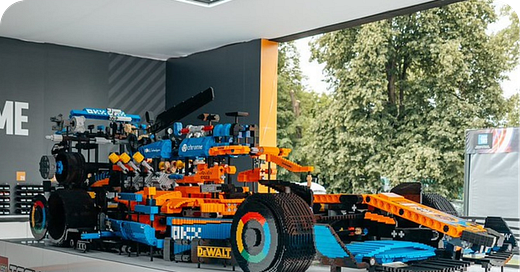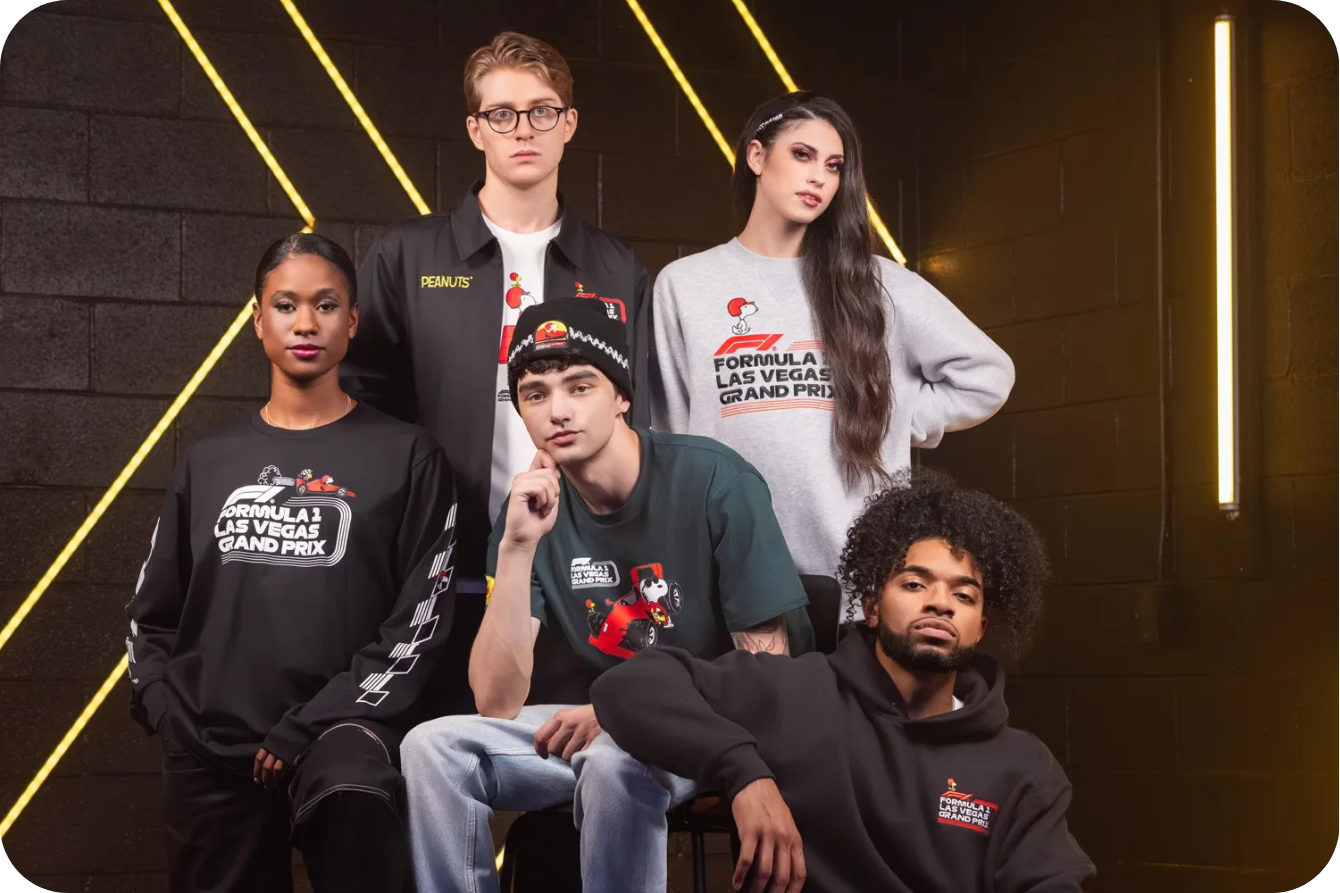How the Consumer Brand Boom Is Redefining F1
From High Fashion to Hot Wheels, Consumer Brands Are Betting Big on the Pinnacle of Motorsport
Hi there! Welcome to Track Limits, a weekly newsletter where we break down the biggest headlines in F1 and explore the questions, topics, and trends that are shaping the sport. Nothing is off-topic and a little fun is always part of the mix!!
Good evening!! This week, I’m excited to introduce our final guest writer for Track Limits’ special feature, Beyond Track Limits — a series where we dive into the topics and trends shaping the sport, with the help of experts and amazing insiders!!
In today’s issue, Aurélie — a communications specialist — explores how Formula 1’s sponsorship landscape has evolved from tobacco and tech companies to a booming era of consumer brands, transforming how the sport engages with fans and shows up in mainstream culture.
Many many many years ago, I wrote my International Business degree’s dissertation on the impact of tobacco sponsorship within Formula 1 and its upcoming ban. I knew no one in Formula 1 at the time, my sources were books such as the Piranha Club, magazines like Autosport and F1 Magazine, as well as the limited information available on the internet. I still have it but refuse to re-read it. I suspect the writing is atrocious, the information wholly fluffy, and with what I know now… Bless student-me, she would not have had a clue.
The conclusion, thankfully, was spot on. Formula 1 would be absolutely fine without apparent tobacco sponsorship (we all know at least Philip Morris and BAT stayed) and was already busy replacing those iconic brands with equally cash-rich companies in other sectors. While there are exceptions, it feels as though the era that followed mostly featured a host of “tech” companies, focused on B2B (business to business) connections, building case studies and adding the glitter that is Formula 1 to their rather dry offerings.
While the influx of cash into the sport was spot on and kept many teams afloat, it meant that brands interested in fans were few and far between. And those that were present, were extremely high-end like Rolex. At the time, F1’s image was that of an elitist technology-advanced sport, rather than the international drama-rich sporting showcase that it is now. B2C brands (business to consumer) simply didn’t see the sport as an attractive option to pour their budgets into. In theory, not being sold to every few seconds sounds quite nice, but with it came less activations in and around Grands Prix, less fun merchandise, less… just less.
Some brands, such as Unilever (deodorants), GSK (energy drinks and sport supplements) and Diego (alcohol) were the exception and enjoyed incredible coverage during that time. I worked with them, I know. And while they were fantastic brands, committing huge efforts to their presence in Formula 1, it still seemed... subdued. I think this may well be because they were largely aimed at middle-aged men, which was who F1 appealed to at the time, and I was not middle-aged or a man.
Fast-forward to 2024 and consumer brands are BACK. Not only are they really really back, but the new wave of sponsorship coming into the sport is interested in the most far-reaching and diverse audience Formula 1 has ever had. F1 is at its most popular and is rightly attracting a calibre of brands unlike anything we have seen before.
Being a Formula 1 fan right now is fun. There are competitions you can enter almost everywhere, there is so much content out there, and attending a Grand Prix is full of experiences.
I have previously written about Charlotte Tilbury coming into the sport via F1 Academy, an incredible achievement by everyone involved on all sides of that deal. Knowing how long it takes to bring sponsors into the sport, I can safely say that we have only just begun to see the effects of this brand choosing to enter motorsport. It has sent out a HUGE message to the world of consumer brands.
And what followed? Lego. The most popular toy for children and adults alike. Already enjoying insanely successful associations with Disney, Harry Potter, Marvel, insert your own favourite… What did they decide to do next? Their Speed Champions series wasn’t enough anymore. They went all in. Formula 1 is coming to Lego, and what has been announced so far better be just the tip of the iceberg. Lego has one of the most successful STEM education programs, active in many countries, and working directly with schools. If F1 successfully taps into that… It’s a game-changer.
I would be hard-pressed to discuss every brand announcement that has followed since, but 2024 really was a stellar-year and there are no reasons why 2025 shouldn’t be the same. The brands that stood out? KitKat (Nestlé) was a great moment; I have been wanting to see a team sign them as a pitstop sponsor for years so let’s see how they choose to activate… Vogue via a Condé Nast media partnership with F1 is really exciting to me; I never expected there would be an opportunity to see the sport I work in featured in the magazine I idolised growing up. What a potentially great way to compound F1’s recent popularity. Again, I am waiting with popcorn in hand to see how this is brought to life.
The Peanuts / Snoopy merchandise collab with the Las Vegas GP was a stroke of genius, Hot Wheels will be one to watch, Mastercard and AMEX both come on at a global level, Levis with McLaren was seriously significant, (following in the footsteps of McLaren x Reiss by pushing what F1 Teams merchandise can look like, and entering the mainstream high street space…) Let’s see what the papaya team does next!
Last but not least… LVMH. Now that is a big deal. Bringing in Moët Hennessy and TAG Heuer back in at F1 Global Partner level already, I cannot wait to see what else they do with their 75 brands to potentially choose from. Louis Vuitton was also mentioned; the Monaco GP has gifted its podium finishers with a bespoke LV trunk to carry their trophies since 2021, so the brand does already have a presence in F1, but this will undoubtedly be nothing compared to how they use their global partnership. And with Pharrell Williams as their Creative Director? The potential is huge.
Being a Formula 1 fan right now is fun. There are competitions you can enter almost everywhere, there is so much content out there, and attending a Grand Prix is full of experiences. Simply visiting a city with a GP taking place nearby is hugely rewarding. Montreal used to always stand out for me as the place that gave you a great time regardless of whether you had tickets to the race or not. You always knew F1 was in town.
Nowadays, Montreal has serious competition. Austin has events every day in the run up to race day, Singapore delivers its F1 week with such passion, Las Vegas is… I’m not sure I have words to describe that one… Monaco is FULL. It’s literally just full. They should have a one-in-one-out policy at the border.
Sponsors, partners, brands… however you choose to describe them, may not seem like they contribute to the excitement that comes from a brilliant closely-fought F1 season, but who do you think funds the teams? Most if not all the money each partner brings will go towards developing the cars. At F1 level, funds help make the sport more engaging in a myriad of ways. And the experience you get in and around F1 races? That’s thanks to brands, especially the consumer-facing ones. And long may that continue.
Aurélie Donzelot brings over 20 years of unparalleled experience in the fast-paced world of motorsport, having worked across all levels of the industry. Previously serving as Head of Digital Media for the Alpine F1 Team, Aurélie is a recognised Formula 1 expert with a proven track record in delivering innovative solutions and intuitive strategies that elevate motorsport brands on the global stage.
Her expertise lies in crafting compelling narratives, managing high-stakes situations, and building authentic connections that resonate with fans and stakeholders alike.








"Most if not all the money each partner brings will go towards developing the cars." Not with the budget cap it doesn't. It goes into the owner's pockets and the three highest paid staff members. The engineers and staff aren't really on good wages at all. F1 talks a big STEM game but the opportunities they offer are increasingly unattractive.